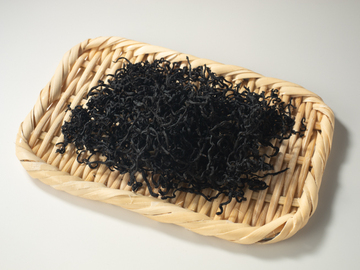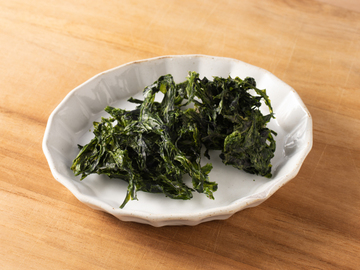Seaweed products

History and culture
Seaweed products are one of major Japanese traditional foods along with rice and fishery products. It is said that 1,500 kinds of seaweed grow naturally in Japanese waters. They have a long history and were appreciated as offerings in Shinto rituals in the era of the Yamato Dynasty. Under the "Taiho Ritsuryo Code", seaweed was subject to taxation. In the Edo era, with the development of traffic networks, kelp, laver, wakame, tengusa, hijiki, funori, and other seaweed products came to be distributed around the country. Dried seaweed products are light in weight, which is considered to have contributed to the spread of seaweed products.
To produce seaweed products, different processing methods that consider the characteristics of different ingredients were developed. Such processing methods include the method of drying seaweed with seawater on it called "suboshi", the method of drying seaweed sprinkled with rice straw ash or wood ash called "haiboshi", the method of braising and then drying seaweed called "niboshi", the method of using a papermaking technology called "sukiboshi", and the method of pickling seaweed in high-concentration salt called "enzo (salt-preserving)". All of these methods not only help to make the shelf life of seaweed longer but also increase the flavors.
Today, approx. 50 kinds of seaweed are eaten in Japan. The characteristics and color of seaweed depend on the depth of water and habitat where it lives. For example, brown algae such as kelp and wakame, red algae such as laver and tengusa, and green algae such as green laver and sea lettuce are eaten. These are cooked by different cooking methods and eaten in a variety of dishes such as simmered dishes, soup, vinegared dishes, vegetables, fish, or shellfish dressed with various seasonings, and sushi.
Characteristics and types
Three kinds of seaweed products are outlined below.

[Brown seaweed (kelp, wakame, etc.)]
According to "Shoku Nihongi (Chronicle of Japan Continued)" (797), kelp had already been presented as a tribute to the Imperial Court in the Nara era. It was also used as a memorial service for priests, and was valuable at that time. In addition, there is a record that in the Edo era, kelp grown in the Matsumae Domain (Hokkaido Prefecture) was processed in Tsuruga Port (Fukui Prefecture) and transported to Kyoto Prefecture. Processed products of kelp include kuro tororo (black shavings of the surface of kelp), shiro tororo (white shavings of the inside of kelp), oboro konbu (kelp shreds), and shiroita konbu (whitish kelp sheet), suggesting that kelp has been rooted in the Japanese diet since old times. Kelp is also called "hirome" or "ebisume," and has been considered as a lucky charm from long ago.
Similarly, wakame has a long history as a tribute from long ago. It is said that wakame, which had been produced over wide areas in large quantities, was given to craftsmen as salaries in and after the middle ages.

[Red algae (laver, tengusa, etc.)]
It is said that laver is a special product that has been eaten since the era of Emperor Suiko (the 7th century), and the name "nori," which means laver in Japanese, spread in the early Edo era. Cultivation of laver started in the Edo era, and laver products produced by using a papermaking technology were considered as products with high commercial value.
It is said that "tokoroten", a food made by boiling and melting tengusa, was introduced in the Nara era, and it had already been available under the name of tokoroten on the market in the Heian era. In the Edo era, the technology for producing dried tengusa was established, and it was eaten widely as a snack between meals by ordinary people.

[Green algae (green laver, sea lettuce, etc.)]
It is said that green algae (green laver and sea lettuce) became widespread in the Edo era, and they have been used as ingredients of vinegared dishes or soup. Methods for processing green alage are simple. Basically, gathered green algae are eaten as they are or washed with water and sun-dried.
Production methods
Seaweed products are produced using two major processes: drying and salting. Before these processes, simple pretreatment processes such as washing, cutting, boiling, and sprinkling with ash take place. Salt, vinegar, rice straw ash or wood ash, rice bran, soybean products, and other ordinary foodstuffs are commonly used as the ingredients.
Relationship with regions
Some of seaweed products that have undergone development unique to a region are introduced below:
[Naruto haiboshi wakame]
"Naruto haiboshi wakame" is ash-sprinkled and dried wakame produced in the area around Naruto City of Tokushima Prefecture. Since wakame has been produced in this area from long ago, many wakame producers and sellers existed and completed with each other over their skills. Due to this background, special products with high commercial value were developed, one of which is Naruto haiboshi wakame. It has a fade-free bright green color, and an elastic and easy-to-bite texture like fresh foods.

[Agar]
Agar is made by drying "tokoroten", which is made by boiling and melting tengusa and hardening it by cooling. Agar is divided by shape into some types such as string-type agar called "hoso-kanten" or "ito kanten" and agar in the shape of a rectangular bar called "kaku-kanten" or "bo-kanten." Agar originated from a mistake made by Tarozaemon Minoya, who ran an officially appointed inn called "honjin" in Fushimi, Kyoto in the Edo era. When he left tokoroten outside at night in winter, it was frozen. After that, however, he found that the frozen tokoroten melted during daytime and then was dehydrated into a dried food with a mild seaweed flavor. There is an anecdote that the dried food was named "kanten," which means cold agar, after this unforeseen accident by Ingen, a priest in Obakuzan Mountain.
The production technology developed mainly in the Kansai region including Settsu and Tanba.

[Ita aonori]
Ita aonori is a product made by shaping Enteromorpha prolifera into a sheet and drying it. This production method is the same as for the production method for ita nori, sheets of laver commonly seen on Japanese tables, but such dried sheets of green laver are rare in Japan, and the culture of eating ita aonori has been introduced in a certain area of Chiba. Ita aonori is a foodstuff that is indispensable for zoni, a Japanese rice cake soup dish usually eaten in the New Year. It is said that Enteromorpha prolifera adhering to eel fishing implements was dried and sold in the early Meiji era and this is the origin of ita aonori.
Contribution to sustainability and SDGs
In the process of growing, seaweed photosynthesizes and absorbs carbon. Carbon accumulated in marine ecosystems is called "blue carbon," which is attracting attention as a new alternative source of CO2 absorption.
In Japan, the "Green Food System Strategy" was developed by the Ministry of Agriculture, Forestry and Fisheries in May 2021, which states that it would promote increases in productivity and sustainability in the agricultural, forestry and fishery industries in the medium- and long-term. It promotes the immobilization of CO2 by using seaweed as one of specific efforts.
Various products using seaweed, which is considered environment-friendly foodstuffs, are being developed.
(Goa 13: Climate Action)
Reference
tentative translation: Blue Carbon as a Source of CO2 Absorption and Its Prospects for the Future
tentative translation: Beautify Beaches in Japan Using Blue Carbon, (5) Efforts to Promote Use of Blue Carbon in the Ministry of Agriculture, Forestry and Fisheries), column for fisheries promotion written by Kentaro Higuchi, Tokyo Fisheries Promotion Foundation
Front page of the website for the Green Food System Strategy (Ministry of Agriculture, Forestry and Fisheries



